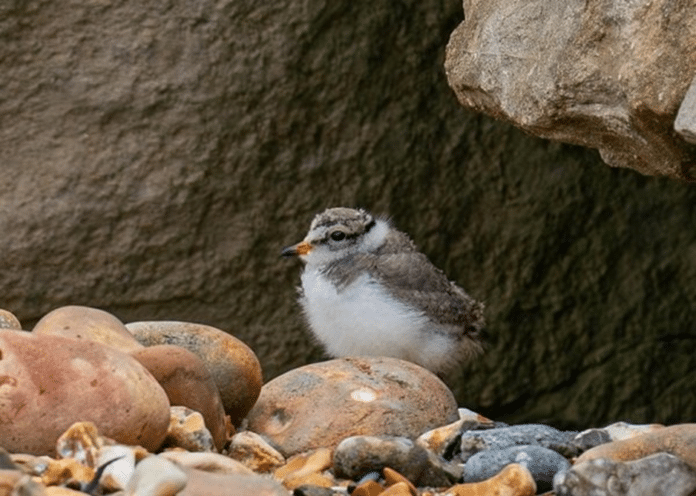A pair of Ringed Plovers have raised two chicks in the fenced area at the tip of Mudeford Sandbank
The fenced area was created in 2020 by BCP Council and CHOG after Oystercatchers bred there in 2019. One of those chicks was taken by dog and the Echo ran a story about it, which went national
The Ringed Plover nest was discovered in June and very quickly a cage was put over to protect the eggs from predators, while allowing the plovers in and out.
Three eggs were laid and all three hatched and, until last week, all three chicks survived. One has since been lost, it’s not known how, but the remaining two are now capable of flight.
The birds have been protected not just by the fence, but also by the efforts of beach hut owners who have put up signs and provided information for visitors.
David Taylor, Secretary of the Christchurch Harbour Ornithological Group, comments. ‘Ringed Plover is a red-listed species, meaning it decline as a UK breeding bird has the highest level of concern, so this event is a major conservation success for the area. Thanks go to all parties and individuals who have contributed so positively.’
David Taylor
The Enigmatic Charm of the Ringed Plover: A Delicate Guardian of Coastal Habitats
Nature’s diversity never fails to amaze, offering a myriad of species, each with its own unique role in maintaining the delicate balance of ecosystems. Among these avian wonders, the Ringed Plover (Charadrius hiaticula) stands as a prime example of adaptability and ecological significance, particularly in coastal habitats around the world. This essay delves into the life, behavior, and conservation importance of the Ringed Plover, shedding light on the intricate relationship this bird shares with its environment.
A Glimpse into the Life of the Ringed Plover: The Ringed Plover, a small, plump shorebird, captures attention with its distinct appearance. Sporting a mixture of white, gray, and brown feathers, it displays subtle patterns and features that make it perfectly camouflaged in its sandy or pebbly habitat. Its most distinguishing feature, a black band or “ring” encircling its neck and breast, gives the bird its name. This ring, combined with its mellow, plaintive call, allows birdwatchers to identify the species even from a distance.
Ringed Plovers have a wide distribution, found along coastlines across Europe, Asia, and North America. Their preferred habitats are sandy or shingle beaches, mudflats, and rocky shores. These birds are highly migratory, spending their breeding season in northern regions and migrating south during the colder months.
Behavioral Patterns and Adaptations: Despite their unassuming size, Ringed Plovers exhibit a fascinating array of behaviours and adaptations that enable them to thrive in challenging coastal environments. Their foraging strategy involves probing soft substrates with their slender bills, seeking out small invertebrates like worms, crustaceans, and insects. Their keen eyesight and quick reflexes aid in capturing their prey, as they dodge waves and retreat from incoming tides.
Nesting is a delicate endeavor for the Ringed Plovers, as their chosen sites are often vulnerable to disturbance. Their nests consist of shallow scrapes in the sand, lined with bits of debris to blend in with the surroundings. This choice of nesting sites provides some camouflage but also leaves them exposed to predators, both avian and mammalian.
The Ringed Plover’s breeding season coincides with high human activity in coastal areas, adding to the challenges they face. They are known to engage in distraction displays, feigning injury to draw potential threats away from their nests or chicks. This elaborate charade showcases their dedication to protecting their offspring and underscores their adaptability in coping with diverse challenges.
Conservation Significance: The Ringed Plover, though often overshadowed by more charismatic species, plays a crucial role in maintaining the health of coastal ecosystems. Their diet primarily consists of small invertebrates that inhabit intertidal zones. By controlling the population of these organisms, Ringed Plovers help to maintain the balance of the entire food web in these habitats.
However, the Ringed Plover faces numerous threats that put its populations at risk. Habitat loss due to coastal development, disturbance from recreational activities, and predation are significant concerns. Climate change, leading to rising sea levels and altered shorelines, also poses a threat to their nesting sites. Conservation efforts aimed at protecting and restoring their habitats, implementing responsible tourism practices, and raising awareness about their ecological importance are crucial to ensuring their survival.
In the intricate tapestry of coastal ecosystems, the Ringed Plover stands as a delicate yet resilient thread, contributing to the vibrant diversity that characterizes these habitats. Its unassuming presence and adaptive behaviors underscore the intricacies of nature’s design. To ensure the continued existence of this remarkable shorebird, a concerted effort is needed to address the threats it faces and foster a harmonious coexistence between human activities and the natural world. Just as the Ringed Plover guards its nest with unwavering dedication, so too must humanity become stewards of our shared environment, cherishing and protecting the creatures that enrich our world.
Join us in helping to bring reality and decency back by SUBSCRIBING to our Youtube channel: https://www.youtube.com/channel/UCQ1Ll1ylCg8U19AhNl-NoTg and SUPPORTING US where you can: Award Winning Independent Citizen Media Needs Your Help. PLEASE SUPPORT US FOR JUST £2 A MONTH https://dorseteye.com/donate/







